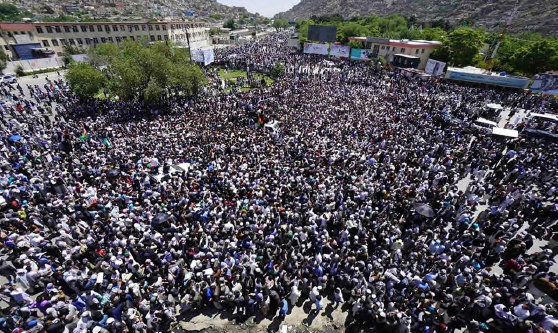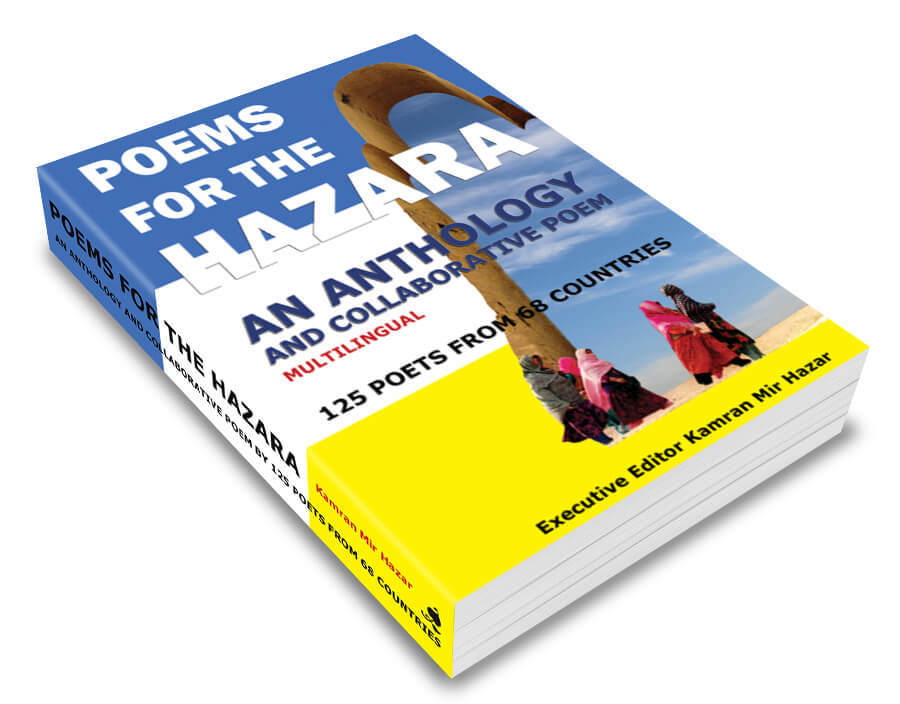
Hazara: Saga of an Entity Fallen Between Cracks
Reading time: (Number of words: )
POEMS FOR THE HAZARA
A MULTILINGUAL POETRY ANTHOLOGY AND COLLABORATIVE POEM
Executive Editor: Kamran Mir Hazar
FULL PAGE PUBLISHING 2014
Reviewed By: Debasmita Ganguly
With Haiku’s Body:
Sometimes they want to chain your hands and feet
If necessary become a fish,
If necessary an elephant saved from extinction!
Kamran Mir Hazar
There you are…standing alone, unable to help yourself…drop a brick and there will be handcuffs locked around your wrists and your feet will be chained. This is what Hazara predicament is all about in their own land, Afghanistan where they have been singled out for centuries only to suffer numbing despair following confounding incitements of religious fanaticism, ethnic prejudice or geo-strategic issues between neighboring countries.
Hazara people mostly residing in the central highlands of Afghanistan among the Koh-i-Baba Mountains and the western extremities of Hindhukush, an ethno-religious zone of Turko-Shia community pitted against the Sunni Pashtuns of Afghanistan. They are also conspicuous in Iran and Baluchistan province of Pakistan along with different parts of the globe. The subjugation of the Hazaras started with the ascension of Dost Mohammed, the Amir of Afghanistan in early nineteenth century as most of them were systematically forced out of modern day Kandahar and other parts in the south.
It found its culminating effect in massive genocide of Hazaras in the reign of Abdur Rahman Khan, popularly known as The Iron Amir who brought with himself a ceaseless flow of tribulation, expulsion and enslavement. Time has moved from one century to another, but the tradition of arranged discrimination against this particular community has remained consistent, unaffected by the dignity that life contains. It is against this backdrop one hundred and twenty-five poets from sixty eight countries have raised their voice in the collection titled POEMS FOR HAZARA, A MULTILINGUAL POETRY ANTHOLOGY, edited by the most prominent Hazara poet and activist of recent times Kamran Mir Hazar.
The anthology begins with the absorbing piece named MY NAME IS FATIMA OF HAZARISTAN, penned by Etnairis Ribera from Puerto Rico. The young Hazara girl narrates in the simplest possible language a story of mimed existence, of burdened history-
“My colors go from dream to pain. Surviving I carry on my
Back our arid millennial history.’’
As the poem progresses, so does Fatima’s latent fear of actuality. However, it ends with a silver lining as she hopes that ‘’the everlasting peace of Bamiyan’s Buddha may flourish’’.
Catalonian poet Angelina Llongueras also lends her ‘distant’ voice to the substantiality of the cause
‘’To cross the mountains
And reach the sea’’.
As we move forward through the pages, the intensity of articulation of the artists keeps on fluctuating, sometimes delving deeper, at others near the sandbars. The determining coordinating factor of course remains the same i.e., a range of sounds distinctive to a group of sensitive minds clenched up by habitual deprivation. Julio Pavanetti, a poet who underwent the inclemency of military overbearing that compelled him to leave Uruguay, puts across in his THE VOICE OF ALL OF US-
The Hazara people’s voice
is the force of the poet
joining his pen to other pens
to plant their looks
of green branches
with their fruits of hope
that would stop the pain’’
Gertrude Fester, a former political prisoner in Apartheid South Africa, presently conducting research on the cardinal reasons of brutality against citizens belonging to vulnerable groups, echoes the same voice in HOPE FOR HAZARAS-
“I will write with wide words shouting of your pain and plight
I will gyrate and dance a dance of freedom.’’
Yes, ‘gyrate’ is quite a fitting word that can describe within its limited stretch the Hazara condition since obsolete ages, a community whose journey is steeped into an atmosphere of fear and suspicion, and anxiety that moves in a circle around distress, be it in suicide attacks in Baluchistan or ethnic persecution anywhere in Afghanistan.
Anne Waldman (SPEAK FOR HAZARA) from America, calls them-
“enigmatic people
travel back in blue time
with mysterious origin…’’
Her words unanticipatedly take us to an idyllic moment out of the realm of perennial turmoil. And we start to envision a life of an early community, their ordinary household routine, the culture that runs through their veins; as in the words of German poet Timo Berger (IN THE EAST)-
‘’traders
commanding camel caravans
bags
full of silk, salt
and spices;
preachers
spreading
his creed;
explorers,
astrolabe’’
Such picture drawn in words gets an identical reverberation in Indian poet Mamang Dai’s nameless work. Here the poet wishes to fly to the land of ‘Red Mountain’. The birds ‘painted blue and gold’, the ‘wandering souls’, the ‘frozen valley’, all create a cumulative acuteness of atmosphere. The poem ends with an equally ethereal expectancy with clouds breaking open and “A shining ridge tilts toward the sun.”
Despite the occasional handling of the content with frisking light, the heftiness of a state of great commotion, confusion and disquiet is unavoidable as we leaf through the book. There prevails in every written verse an anticipation of unpleasant foreboding of a life ripped off. The Dutch poet Quito Nicolas’s words bring out this horror in a way that is formidably great-
‘’Living in fear
Childhood friends who betray you
At the negotiating table
They will spit on us.’
A similar murkiness can be found in Colombian poet Eugenia Sanchez Nieto’s words. Her poem SCARS is a finely etched out document of the gloom, as she writes-
‘’Sufferers of war, weapons, bestial men
fanatics and religions.’’
She further points out-
‘’a wall of tradition and backwardness
Grows inward and outward’’
Erling Kittelson’s HUMAN HAZARA is another enchantingly dismal document of Hazara plight-
‘’the mountain takes down like tent
The tent rises like mountain.’’
In the poem I SAW by Elias Leteier from Chile we perceive this racking excruciation as death is compared to the falling of a star which is turned into ‘pulp of blood and mud’. These words make us to think that gone are the days of warmth and contentment. In Hazaristan the things that are left for its own people are absence of essential human condition and lack of generosity. But here lies the pertinent question: ‘’ Has Hazara community ever received such warmth from his colonial brothers?’’
However, while maneuvering from the beginning to the end of this anthology, one thing that hardly misses our attention is the recurrent image of Bamiyan Buddha, the three colossal statues dynamited in March 2001 by the Taliban on the orders from leader Mullah Mohammed Omar. It is an instance of the extreme religious intolerance of which Hazara community is a regular prey. In fact the faces of the Buddhas were destroyed much earlier by Abdur Rahman during his military campaign against the Shia Hazaras. This abominable crime against cultural heritage and humanity at large is voiced in Yolanda Pantin’s poem titled BAMIYAN-
‘’They destroyed the colossal
incarnation of the Buddha
but to obliterate you
it is not possible.’’
In Indian poet Angelee Deodhar’s THE ROAD TO BAMYAN these effigies along with another prominent imagery i.e. the almond tree with a soft sailing verse capture the soul of a Hazara and a clarion call from the poet-
‘’come walk with me,
hold my hand
guide me now
as my faltering steps slow on the road to Bamyan.’’
Colombian poet Raul Henao also makes noticeable use of Bamiyan Buddha in his poem HAZARA in quite an unequivocal way.
Another striking feature of this collection of poems is the syntactical structure of some of the creations. On the one hand there are some wonderfully written Haikus and on the other some of the poems crafted with masterly prose like structure. Ban’ya Natsuishi, a Japanese haiku artist of prominent stature has contributed five haikus all of which talk of a dismantled entity, as it is clearly formulated in
‘’A sorrow for the future
thrust into
the blue sky of fear’’.
The poet Laureate of the city of San Francisco, Jack Hirschman’s haikus are more politically tilted. They are undoubtedly bold and consuming. His streak of communism for a better social order is evident in the following lines-
‘’We must bring the war
criminals to their knees by
finally the new class.’’
Alvaro Miranda’s A MOON FOR HAZARAS is a unique rendering in a prose structure that exemplifies vividness. Here light and darkness keep tossing overlapping each other. Woman in her various forms and engaged in different activities deepens the eclipse. The ant skin resting on Bamiyan Buddha’s dust, the vegetable market in Quetta valley all come alive. Ostap Nozhak’s poem HAZARA is a show of diversity in this book. A Hazara woman‘s presence is celebrated here. Her ‘temples are full of sun’, ‘hair is full of heat’ and ‘her shadow is full of herself’. She represents mother earth in the poem, taking care of children. She stands as a symbolic representation of the preservation of life against the rough terrains of devastation. Mention must also be made of Hungarian poet Karoly Sandor Pallai’s DALIL ‘DERA. Here the moving use of hard-hitting consonants create an unsmilingly grave atmosphere-
‘’Disarmed, abused, executed: we’re all peoples of Hazara sharing the doom of enslavement and execution. Our future is quelled, drowned into blood by amour-piercing shells of hatred and exclusion.’’
When it comes to structural experiments, Kamran Mir Hazar’s short renderings show remarkable novelty. The poet has innovated a form which does not fall into the traditional haiku pattern, yet retaining some of its traits like highly imagistic language and economy of words. Each piece is preluded with his cult phrase ‘’With Haiku’s Body’’. Mir Hazar’s poems are forthright and capable of striking with a force. As he writes,
‘’With Haiku’s Body:
A Times journalist in Kolkata, October 1893 reports
Amir of Afghanistan has sold ten thousand Hazara captives as slaves!’’
We are reminded of the succession of events that have reduced the status of Hazaras as asylum-seekers in different parts of the world. With limited words he paints a picture of human dignity choked and abused when he writes,
‘’With Haiku’s Body
Aaaah,
they make their crime our crime.
As if we would burn ourselves with
our own hands!’’
Or when he pens,
‘’With Haiku’s Body
They block your Bamiyan-Kabul road; stand in your way and say
you should be beheaded.
They shoot you down; trample your body with horses and then they
Burn you!’’
In his writings a perfect balance between fabric and content is achieved. An intense exotic disposition is portrayed in the poem where he writes,
‘’I came from Ashtarlay to Nili under moonlight!
Haiku was looking at me!’’
And we are left to think, how beautifully his poetry is born in a torn land.
Psychological nowhereness is something which every person who has been subject to deprivation by state or social apparatus, undergoes at some point of time. Most of the poems in this book capture that feeling of rootlessness, be it in Afghanistan or somewhere else in the globe. This identity crisis becomes clear in Andrea Garbin’s nameless poem-
‘’the apocalypse you have it to you every day,
You are not the first ones and you won’t be the last
It is to us, to all of us, now, to make it stop.’’
This general clutched existence of human beings will made it easy for the readers to relate themselves with it as it has enabled the poets across the world to unite to a single tune. It is in this connection Ivan Djeparoski from Macedonia brings forth the Freudian concept of ‘Unheimlich’, meaning unhomely and he begins his poem with-
‘’is it possible that I’ve recently become homeless at home
In our happy Europe only through fear that
Sooner or later, what was suppressed will return again?’’
Seen from this perspective Bina Sarkar Ellias’s voice is extrusive-
‘’We are
all Hazara
black, white,
yellow, brown,
the blood in our veins a shared red.’’
As we proceed to the closure, the most arresting fleck of the anthology arrives i.e. the collaborative poem penned by several poets in quick succession. Each of them works in conjunction with one another and drops the pen just at the point where another starts. The poem begins with Kamran Mir Hazar’s scathing line‘’ Does poetry have anything to do with my people, the Hazaras?’’ and is followed by some brilliant explosions of powerful emotions, like Jessie Kleemann’s –
‘’Ameer your name sounds like Amee’q which means, you
Skin has been taken off of you’’.
Aju Mukhopadhyay writes, ‘’the sufferers suffer in their own territory’’.
Ernesto P Santiago lends his voice as,
‘’…but I am free Hazara,
Full of opportunities.
I exist, ‘cause I exist.’’
The poem moves forward as if gliding on spike board, tormented, bleeding, yet sailing forward and with the words of each poet, it gathers momentum, be it Satchidanandan’s masterly portrayal or Natsuishi’s subtlety. The end comes with Joyce Ahuntantang’s mordacious declaration,
‘’We may never know your name
But language of your face
Is our grenade on their parade!’’
A fitting finale is drawn by an open letter from three hundred and fifty-four eminent poets and other distinguished personalities from ninety-six counties addressed to the world political leaders to look into the gravity of Hazara situation by going beyond token gesture of justice and humanity. It is a call to nab and convict the perpetrators so that the present plight of Hazara life cannot burry its head under a superficial clap of a book launch or some fleeting condemnation of the agents responsible for gunning down Hazara existence.
It may be concluded by saying that if you are looking for some coffee-table free-flowing verse to enjoy delightful reading, then POEMS FOR HAZARA will not probably serve your purpose. One needs nerves of steel to endure the grievous reality that the Hazaras encounter every moment in their own lands and the anthology paints it with some masterly strokes. Though some of the poems deviate from the agenda that brought it into being, they have their own poetic charm, capable of making it a good read. Going through the entire collection will make you feel one pertinent fact that everyone of us is affected by the Hazara misfortune and we all bite the dust if we still claim that we all are part of a modern world even after knowing the transaction of analysis that the book depicts. Between the lines here lies tragedy inherent, dripping with unnumbered screams and
‘’Trampling boots stomp the soft earth’’…

View online : http://www.hazarapeople.com/20...
Related Articles

Poems for the Hazara
The Anthology of 125 Internationally Recognized Poets From 68 Countries Dedicated to the Hazara
Order Now








